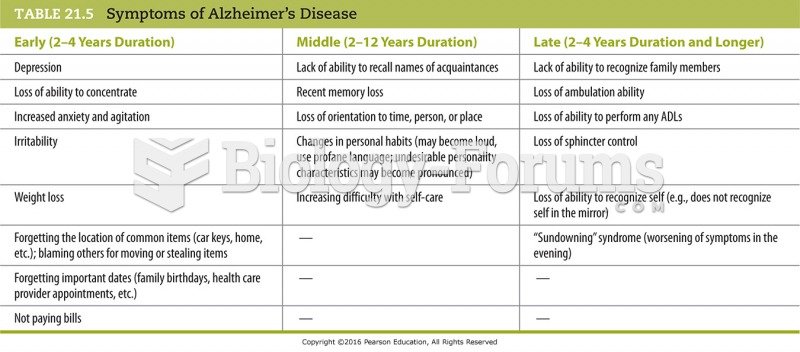Answer to Question 1
C, E
Participating in a regular exercise program is an important nursing intervention to help prevent the risk of falls for this older adult who has clinical indicators of complications from steroid therapy. Steroids are a common therapeutic regimen used during exacerbations of chronic obstructive pulmonary disease (COPD). When needed on a long-term basis, steroids can ravage the skin and the musculoskeletal system of the patient, causing muscle wasting and OA. Thus this man is likely to have below-normal bone density; therefore the nurse instructs him to participate in regular, progressive exercises and pulmonary rehabilitation to build cardiopulmonary reserve, muscle bulk, and bone density to help reduce the risk of falls. The nurse also instructs the patient to eat a high-calorie, well-balanced diet to provide the body with substrate for tissue building and repair. A higher amount of calories than usual are required because patients with COPD work hard to breathe, and this work requires more calories to prevent tissue atrophy. A well-balanced diet helps prevent the risk of falls by supplying the body with sufficient fuel to sustain activity and by increasing bone and muscle density to maintain balance and coordinated movement. Although this man is at risk for below-normal bone density, the nurse instructs the patient to take up to 500 mg of calcium because the system cannot absorb more than 500 mg at a time. To protect the gastrointestinal tract, administering a proton-pump inhibitor is a reasonable nursing intervention for a patient with a history of taking steroids; however, this intervention is not directly related to reducing the risk of falls. Avoiding sick people is a reasonable nursing intervention to prevent the risk of infection for an individual with COPD. The nurse instructs this older adult to cleanse the skin gently and to apply an emollient lotion to maintain skin integrity.
Answer to Question 2
D
Feedback
A Incorrect. Sensations are often most acute in the late afternoon, increasing the risk of sensory overload. Diminished daylight in late afternoon may also contri-bute to sensory deprivation.
B Incorrect. These effects can follow from both sensory overload and sensory de-privation.
C Incorrect. Both conditions may be eased by a nurse who spends time paying at-tention to the patient's needs.
D Correct. Increasing the amount and variety of stimuli can be beneficial in sensory deprivation, but doing so would aggravate sensory overload.







